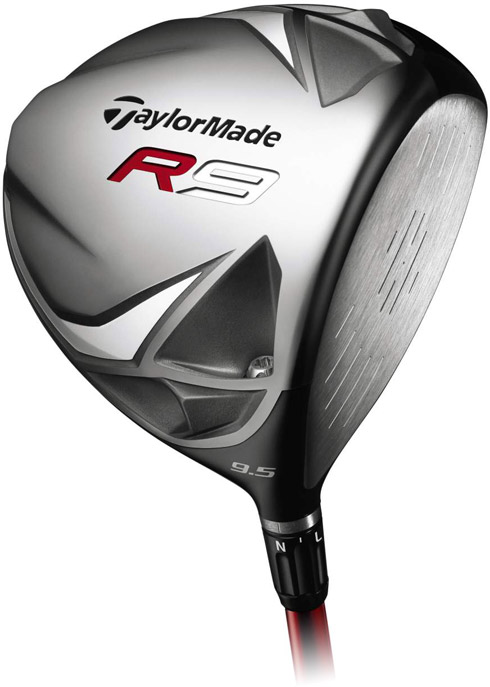 We’ve all seen the ads. We’ve all seen the large number of TaylorMade staffers with “R9” sewn on the sides of their hats or visors. We’ve had it beaten into our heads that TaylorMade owns the tee box. Oh, wait, that was a few years ago. What are they saying these days?
We’ve all seen the ads. We’ve all seen the large number of TaylorMade staffers with “R9” sewn on the sides of their hats or visors. We’ve had it beaten into our heads that TaylorMade owns the tee box. Oh, wait, that was a few years ago. What are they saying these days?
“Until now.”
That’s their new slogan. “Until now, you’ve never had a customized driver.” Or something like that.
Logic aside (I’ve had customized drivers because I’ve gone to get fitted for my drivers), the message is clear: TaylorMade is big on customization, and the R9 not only offers “MWT” for “Movable Weight Technology” but their new hosel adjustment feature, dubbed “FCT” for “Flight Control Technology.”
Suffice to say even if TaylorMade doesn’t own your tee box, they own the most acronyms. Does all of this FCT and MWT make a difference in the R9 driver? Read on to find out.
Design and Technology
The newest addition to the TaylorMade driver line is, again, FCT or “Flight Control Technology.” Essentially, it’s an interchangeable hosel (attached to a shaft) that you affix to the clubhead by a screw that’s not perfectly aligned with the shaft’s axis. Rotating the hosel/shaft thus changes the angle at which the shaft enters the clubhead, and thus alters the club’s face angle, loft, and lie.
The FCT sleeve is made from 7075-T6 aluminum alloy and is “ringed around the bottom with small teeth, which tightly mesh with a second ring of matching teeth within the hosel.” You alter the clubhead’s face angle, loft angle, and lie angle by loosening the FCT bolt, removing the shaft from the head, rotating the sleeve and shaft into the specific position you desire, and then locking it all into position with the supplied wrench.
Prior to FCT, in order to change the face, loft, and lie angles you had two choices. First, you could rotate the club in your hands and adjust your setup slightly. The second option was to make friends with your local clubmaker and have him bend the hosel for you – a sometimes dicey proposition and certainly not something you’d want to do every few days.
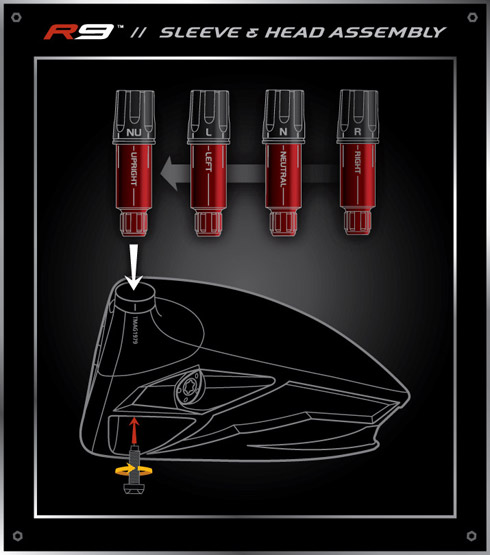
For those of you who have previously used the r7 line with the Moveable Weight Technology (MWT), the R9 is no different in this regard. The clubhead has three weight ports and comes with one 16-gram and two 1-gram weights. Put the heavy weight in the heel port to give you a draw bias, the toe port to give you a fade bias, and in the middle port for straight flight. According to TaylorMade, with all the various clubhead characteristics settings and weight configurations, you have up to “75 yards of side-to-side trajectory change” – 35 of which comes from MWT and 40 from FCT.
The new wrench can be used with both the FCT bolt and the movable weights and is designed specifically for the R9 as the bolt requires 40 inch-pounds of torque to tighten fully (older MWT wrenches deliver only 30 inch-pounds of torque). Just like the older wrenches, the R9 wrench “click” when either the FCT bolt or MWT weights have been tightened.
The R9 driver has a new clubhead shape that combines the shape of the r7 SuperQuad with the r7 Limited, which is a more triangular shape with “beautifully contoured corners.” According to TaylorMade, “the triangular shape offers four distinct advantages:
- It allows for a deep back, far-from-the-face CG location that makes it easier to launch the ball.
- It contributes to a higher MOI for greater stability on off-center hits.
- It allows for an exceptionally low CG location that’s lower than that of the r7 Limited and the r7 SuperQuad.
- It works more efficiently with MWT, allowing it to use only three ports and cartridges to “more effectively influence trajectory than the r7 SuperQuad could with four.”
In addition, the R9 utitlizes TaylorMade’s “Ultra-Thin Wall (UTW) technology” which allows the clubhead walls to be be a scant 0.6 millimeters thus allowing more weight to be moved for the Moveable Weight Technology and a lower and deeper center of gravity to be possible. Less weight equals more speed.
Toss in the old reliable Inverted Cone Technology and you get a clubface that has an expanded area that serves up higher ball speed. Higher moment-of-inertia, lower center-of-gravity and the Inverted Cone Technology gives you a much more forgiving driver.
Esthetics
Though I appreciate TaylorMade’s attempts to redefine the word “classic” as it pertains to driver head shape by calling the subtly triangular shape of the R9 “new classic,” I disagree with the term and still dislike the look to a small degree. Count me among a small minority, but I still prefer the pear or at least circular shapes of the truly classic drivers. I played for quite awhile with an r7 425 TP and its circular head, but haven’t really cared for any of the square or triangular heads I’ve seen since. I’ve gotten used to them – no doubt – but “like” and “got used to it” are two very different things. To TaylorMade’s credit, the triangle shape is quite soft – it’s nearly round – and I appreciate their efforts in that regard. The R9 is not bad to look at – it’s just not great.
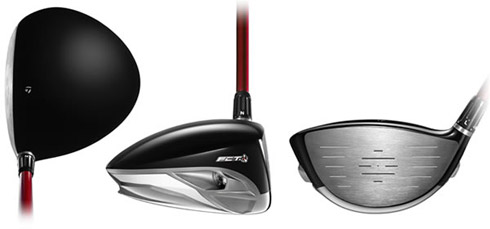
Beyond the shape, I like everything else about the looks of the R9. The dark red shaft connotes power and a bit of sinister intent – not a bad feeling standing over a golf ball. The manliness continues on the sole with the angled ridges and edges that do a little to mask the MWT and FCT ports. The angles, ridges, and lines look “high tech” and “futuristic” far more than any set of rounded edges I’ve seen on a driver.
The darker greys and blacks offset the simple sole markings which say simply “TaylorMade R9.” Any other markings on the club are hidden beneath the hosel (the loft) and FCT logo is hidden on the toe where the “TP” logo usually hides (the TP and non-TP heads are the same – only the shafts differ in the R9 and R9 TP).
The hosel’s FCT markings are primarily on the inside of the club except for four simple abbreviations: R, L, N, and NU to make the settings visible at a glance. The hosel itself has fluted edges and looks a bit like a longer version of the hosels Callaway has used on their metalwood for a few years. The simple crown is completed with a “T” logo behind the center of the clubface and a shiny, black, non-speckled finish.
Apparent size isn’t so much an issue with the R9, as the clubhead is only about 420cc. No doubt TaylorMade had to put some extra weight in the heel for the FCT, necessitating the smaller clubhead size in this first version (a 460cc version is reportedly on the way), but I like the smaller clubhead. Too many of the 460cc drivers look like balloons on sticks, and though some clubs mask the size well, the R9 doesn’t need to. Some people might even wish it looked a bit larger.
Performance
I must admit that I was tempted to simply link to our TaylorMade r7 Limited review and say “R9 = r7 Limited + FCT.” Essentially, that’s how I feel about the R9 – that it’s quite like the r7 Limited with the addition of FCT.
How much that addition of FCT adds, well, that will vary from person to person.
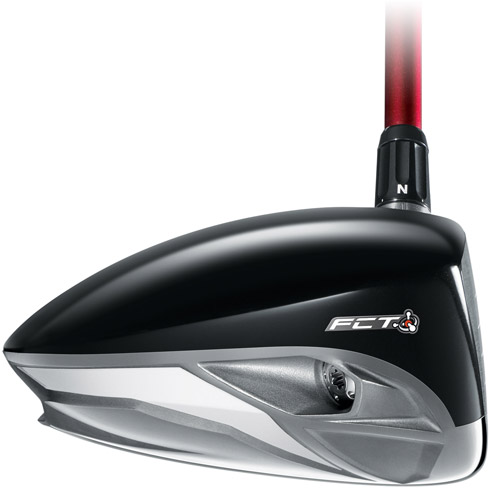
MWT and FCT are important for one reason: custom fitting. Golfers who buy a club off the rack without being custom fit or even trying different settings are missing out. With MWT and FCT, golfers can do a lot of the custom fitting themselves. Sure, they’ve still gotta pick a shaft that suits them, but after that they’re free to adjust draw/fade bias, lie angle, loft, and more with MWT and FCT.
TaylorMade realizes that custom fitting isn’t very sexy, so beneath their “change your ballflight” marketing lies the tone that you don’t change it to get a club that works for you, but rather to change your ball flight to suit conditions or the course you’re playing that day. I can count on one hand the number of golfers I know who have ever changed their MWT or their FCT once they’ve got it set optimally for their swings. I’m guessing you’re probably the same way.
We’ve had MWT for a few years, and we know how it works. In my own tests, I could get a hard draw with the 16-1-1 configuration, a baby cut with 1-16-1, and a high cut-slice with 1-1-16. If I wanted a baby draw, I was out of luck just using MWT, and some have raised the point that it’s a little cheap of TaylorMade to give you only three weights. You can order more or, if you’re like me, use the weights you might have from prior TaylorMade equipment.
A brief aside: testing these sorts of things is fairly difficult. I’m either too smart or too stupid to swing the same way every time. If I know I’ve set the club up to make the biggest hook it can, my body tends to instinctively fight that. I had to test blindly – by having a friend configure the club and not tell me what settings he’d chosen until I hit a few balls with as close to a “stock” swing as possible.
The 35 yards TaylorMade claims you get just from MWT? It may be a bit of a stretch, but you can certainly get from one side of the fairway to the other – a good 20 or 25 yards – with MWT alone.
Moving on to FCT, the hosel has eight positions ranging from neutral (which is actually 1° flat) to “Right” (with a neutral lie angle), “Upright” (1° upright), and “Left” (again with a neutral lie angle). The difference might only be two degrees, but it’s noticeable.
TaylorMade’s literature is a bit confusing regarding FCT, but it largely depends on what type of golfer you are. For example, take the club I reviewed – an R9 TP with 9.5° loft and a Fujikura Motore F1 65g shaft. In the Neutral configuration, the club has a square face angle and 9.5° loft. Fortunately, the stock shaft is only 45″, not the 46″ or 46.5″ that TaylorMade and others have been sneaking into their drivers in the quest for more distance.
Let’s move to the “Right” FCT position. This opens the clubface two degrees (and makes the club a degree more upright). TaylorMade’s documentation shows the “Right” setting as producing a lower shot than “Neutral,” and that’s true if you close the clubface to get it back to square. You’re reducing the effective loft of the club. But then how the ball goes right (particularly with the more upright shaft angle), I don’t know. The alternative is to leave the clubface open two degrees, which has the effect of increasing the effective loft. But at least you know the ball will go right.
I’m not sure which type of player you are, but I prefer the latter method, which again contradicts what TaylorMade will tell you about the relative heights of the “Left” and “Right” positions.
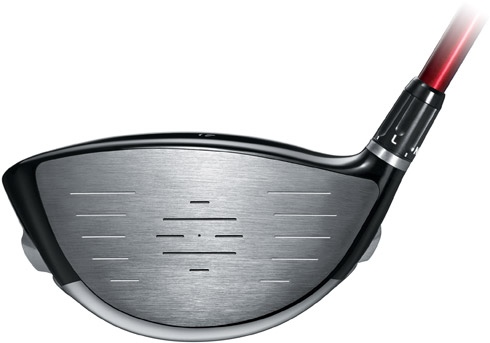
Since my “miss” tends to go left, I chose a neutral weight setting and the “Right” FCT position with the R9 I tested for this review. I let the face hang open at address like it wants to in that setup and trusted that I could be aggressive through the ball without fear of going left.
When you make contact with the ball on the center of the face, the ball comes off quite nicely – with a mid-high trajectory, decent spin rates, and a flat, boring ball flight. It’s no longer or shorter than other drivers on the market in its best personalized configuration, but that’s to be expected – we’re awfully close to the distance ceiling with the current rules and technology.
Catch the ball a little higher on the face – as little as a quarter to a half an inch – and wow the thing becomes a launcher. The ball just goes. It starts a bit higher, it spins a lot less, and it just floats out there with tremendous carry. There’s a mid-length par five I’ve never reached with less than a 4I before that I reached with a 6I after teeing off with the R9. That round was played in early spring, and my ball only “rolled” (if you can call it that) one yard in the soggy conditions.
Unfortunately, you seem to need to catch the ball on the center of the clubface and a bit high to get everything out of this driver. Balls caught low or towards the heel or toe felt a bit dead. Less so on the low ones, and more so – surprisingly so – on the heel and toe hits.
The heel and toe hits still offer a good amount of shot correction: heel hits will come off low and try to cut back, while toe hits start high and try to draw. The distance penalty for low/heel/toe mis-hits is what gets you, though. Shots for which you might expect to lose 15-20 yards with other modern drivers lost as much as 35 yards with the R9. It’s been awhile since I’ve hit a 420cc driver, but 440cc drivers didn’t exhibit anywhere near this much penalty on these types of mis-hits, so I’m not convinced it’s simply a matter of clubhead size. The R9 has been widely and quickly adopted on the PGA Tour, but those guys don’t miss on the toe and heel. Though I tend not to miss on the toe or heel myself, I think the lighter shaft increased the frequency of those types of mis-hits.
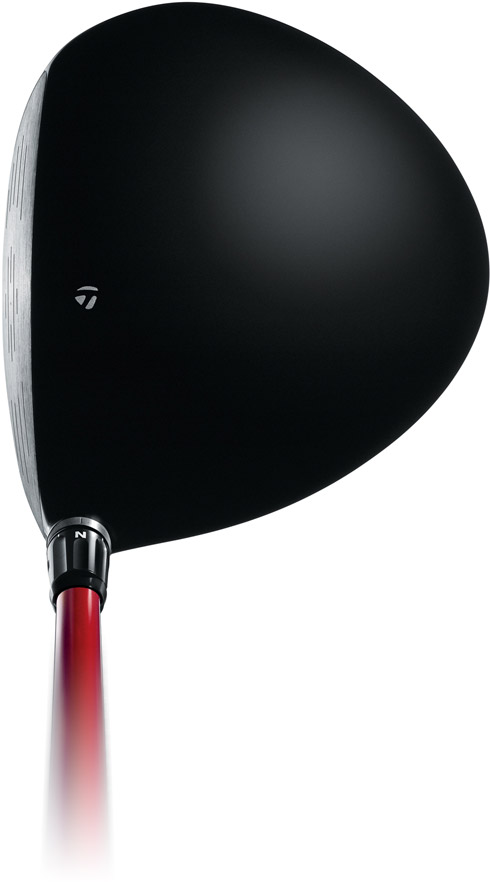
Back on the plus side, and despite the triangular shape which leads you to believe the R9 is a high-MOI driver that resists working the ball, it’s quite easy to move the ball left-to-right or right-to left from any of the MWT/FCT configurations. Essentially, once you get the MWT/FCT setup that neutralizes your misses and plays into your stock shot shape, I think you should be able to work the ball about as well as your skill allows. This may be more difficult with the eventual 460cc version, but with the current R9 it’s just about right – a little forgiveness and a good amount of workability.
Sound at impact varies greatly across the clubface. Again, heel/toe hits sound a bit dull, and high and low hits vary in pitch and amplitude a bit, but center contact is incredibly pleasing. The pitch evokes a solid sound and is about as good as it gets with a titanium driver.
All told, except for the slightly higher trajectory than I might otherwise like from a 9.5° driver, the club performed incredibly well. You know, like you’d expect an r7 Limited with the addition of FCT to perform. <grin>
Specs and Extras
The R9 driver will be offered in 8.5°, 9.5°, and 10.5°degree lofts for righties and 9.5° and 10.5° for lefties in X, S, R and M shaft flexes. The MSRP is a cool $500 (about $400 street), while the R9 TP comes in 8.5°, 9.5°, and 10.5° lofts for righties and 9.5° and 10.5° for lefties in X, S, and R shaft flexes. The MSRP is $600 (about $500 street), and you can pick up either one of these bad boys starting on March 20, 2009, which is conveniently around my birthday. Thank you TaylorMade!

The available R9 shafts: Motore 65, 65 TP, 75 TP, and 85 TP. They all look the same, but I dig the red!
The shaft for the standard version is a Fujikura Motore graphite shaft with High Inertia Tip (H.I.T.) technology (kudos to the marketing folks for that one). The 65-gram shaft has an advanced tip construction to help promote a faster ball speed. The R9 TP comes with a Fujikura Motore F1 65-gram shaft with H.I.T. engineered to be slightly stiffer and with lower torque. 75- and 85-gram shafts are also available.
Conclusion
Discussion on the forum seems to be mixed: some love the club, but many talk about a dead feeling. I’m not sure if they were hitting the heel or toe with a lot of their shots, because that’s the only time I had a feeling that I’d describe as “dead,” but the feeling does exist.
The majority of the time, the R9 performed as well as you could expect. The 420cc clubhead proved plenty workable and moderately forgiving. Though I don’t like the triangular shape, it’s subtle enough that it’s not a real concern (I debated even mentioning it a second time). The club exudes manliness and power.
MWT and FCT are both wins in my book, again if for no other reason than the “built-in” customization options they afford to golfers who might otherwise buy off-the-rack clubs and be constantly guarding against their “big miss.” Again, for me it’s a shot that goes left, and the R9 in the “Right” configuration straightened things out nicely. Caught cleanly or a bit high, distance was great and the club sounds tremendous.
$400? That’s your call. If you don’t need the FCT, well, the r7 Limited doesn’t cost very much these days…

i agree with you on the feel aspect if the club is not sruck well. I would have liked to see some of your pictures!
I might still add some. Pictures are the last thing we add and it wasn’t until today that I noticed I hadn’t taken any yet. I normally take them first thing, but I think that when I got the R9 we still had snow. 😛
Great review Erik.
I tested the TP version with the Matrix X-Con 5 shaft and simply loved the ‘feel’. I find it (visually) easier to hit with a 3 wood than the driver and the smaller 420 cc club head with the minimalist design on top gave me more confidence at setup. Also, I feel that there is more feedback here than my current Cobra HS-9 driver. I am looking forward to getting it (will take 2-3 weeks) and enjoying it during the season. Is it worth $500? I could care less for the FCT/MWT as I am never going to adjust this thing while playing or perhaps even otherwise. IMO, I am paying for feel, sound, & looks :-).
What can you tell me about the shafts and which ones promote higher or lower launch angles? I am about a 2 handicap and currently use an older r7 with an 8.5* loft and stiff shaft. With it, I tend to have a very high ball flight and would like to get it down somewhat. When I really move it I can get the ball out to around 300, but more often than not hit it about 275ish. I was reading something and it said that if you hit it 275 you should use an extra stiff shaft. I’ve always used a stiff shaft and thought the extra stiffs where just too hard to hit. I love my driver, but wish I could bring my ball flight down. Any thoughts?
I haven’t hit either, but it certainly looks like the r7 Limited, Part Deux.
Speaking of the R7 Limited review… I didn’t see anything in there about feel or sound. Is it pretty similar to the R9?
If I’m going to get a TM driver, I don’t need to spend $200 extra (or $250 extra for the TP) for FCT or THC or DMV or whatever acronym it is if they are essentially the same otherwise.
One thing I wanted to point out but couldn’t find the place to do so: altering the FCT position obviously rotates the grip as well. With some grips that’s okay (even if the logo is 45° off-kilter), but with some of the more popular grips like Golf Pride’s New Decade Multi-Compound, it’s going to cause problems.
yeah my dad got the multi compound and cant change the shaft otherwise it gives him blisters. Anyone been able to find some r9’s with anything other than the motore. On TM’s website they have the fubuki and a couple others but my shop doesnt carry them.
Nice review. Looks like a nice club, but as a Mizuno MP-600 owner I still wish Taylor Made’s MWT wasn’t so proprietary. I do like the smaller clubhead. By the time I’m ready for a new driver in a year or so I’m sure the price will be pretty reasonable, especially with the 460cc version on the horizon.
Be careful with this driver, sleeve makes tip very stiff.
Tried reg and stiff shaft neither helped.
R 7 limited as good or better.
This not a wow club. Save ur money, or at least try it a lng time before buying.
Do NOT buy into the hype!!!!
Trust me and my friends.
Just a helpful warning.
What a well written review…I’m trying to find out what parameters the loft angle can be changed to…ie) a 10.5 degree loft…can it be changed to 12 degrees? 9 degrees?
thanks,
Brian
Great idea I’ve heard from some golf shops: If you’re going to buy an R9, ask a golf professional/instructor to take 10-15 minutes to help you get the specs dialed in. Having another set of eyes, especially one that knows what to watch for with ball flight, will help you get the best fit faster than trial and error on your own.
To me, that’s the great advantage of the R9 – it’s a truly custom-fit driver you can take home immediately, instead of going through a fitting then placing an order. But you only take advantage if you have some expertise behind your configuration.
I just noticed the release of the R9 360 version of this driver. Will it never end? What’s next? I’d like to say that a 360 version with draw bias is next, but essentially the shaft adjustment takes care of that, maybe?
What ever happened to one or two drivers every couple of years; enough time for anyone to get settled in?
Be it far from me to say, but Taylor Made is part of the problem and certainly not the solution. More than annoying to say the least.
It would be really really REALLy sweet to see a review of Callaway’s FT-9 driver. 🙂
Now if I could just putt.
Its good to see the innovation, imagine being able to change loft, lie angle an so forth, just by using a sleeve that is essentially slightly offset to the shaft. Its very good design, one has to admit.
The problem for me is and which has been cited is that I never change these things, shaft angle, the weights and what not. In fact being a 14 handicapper, I just don’t think I am good enough to get the trajectory I’d like to get given the wind or course conditions or whatever.
So best to pass on this thing and just be happy with my 220 or 230 yard drives I now get with my current driver, at least they are on the fairway.
What I need is a swing that works all the time, now can Taylormade help me with that? Practice you say?
Great review, my current driver is a mp600, and not a bad club. I have got my hands on a tp r9 9.5 with a diamana ki’lli (?) x stiff.
awsome driver, comes out lower and more penetrating, though not a huge amount more carry, but definatley more roll out. It is now in the bag!!
And aesthetics is not spelt esthetics, this drives me mad!!!
james
The max size is 460cc – the next version will be R9 460 not 360 – this isn’t the X-Box
No – it will never end as long as they are in business, they do make clubs after all.
You do know you don’t have to buy it right? You can still “settle in”. The only difference caused by the release cycle is that right now you can get an r7 Limited for ~$120 on eBay or used in a store – less than 50% of retail less than a year from its release. This doesn’t hurt people buying new drivers but it kills people selling a previous model…
Great review – and very helpful!
Two lines really caught my attention:
“I must admit that I was tempted to simply link to our TaylorMade r7 Limited review and say “R9 = r7 Limited + FCT.” Essentially, that’s how I feel about the R9 – that it’s quite like the r7 Limited with the addition of FCT.”
“If you don’t need the FCT, well, the r7 Limited doesn’t cost very much these days…”
So I went with the r7 Limited and I’m truly happy with it. Workable but still very controlable. If you let it, it just wants to go straight (with an tendency to pull the shot a bit to the left, as George pointed out in his review on the r7 Limited). The Matrix shaft is definitely a plus – even if it is “only” a “made for” version.
Hi CS. I have just tried the R9TP with the adila voodoo shaft option. There are two, the VS6 and NV6. The NV6 is a lower launch, lower spin version and in stiff it worked really well. I was looking for something simialr to you and this worked better than the Motore F165 in the TP version. (TP version only differs because it has a different shaft option, the head is the same). In this configuartion, I reduced launch angle to 13-14 degrees and gained more penetration, greater carry and roll. Added about 20yards of average extra carry and additional roll.
I play off 4 with a swing speed of about 101-103 and the SNV6 Voodoo shaft on the R9TP worked best for me. Try a custome fit at there centre f excellence.
Hope this helps.
I just bought this driver and have only played a few rounds, so take this review with that in mind. I hold a USGA +.03 handicap.
I have been playing the Titlist 905 for a while and had no interest in changing the driver. I went looking for a new 3 wood because I have never enjoyed playing the one I had. I hit almost every 3 wood that is on the market, and the R9 3 wood was the best. (Easily workable, 10 yards larger and great overall weighting) So, I decided to try the driver and right away I fell in love with it.
I am not a player to change club, I have played my irons for over 10 years before I gave them up. I hit the R9 about 15-20 yards longer then the 905. I averaged around 290 yards with the 905 and the R9 I am averaging 310. I also did my due diligence, and tried almost every new driver on the market. I did not buy the club for the “changeable features†because I believe that the player is the one responsible for hitting the ball in the fairway, but the feature can come in handy on certain courses. For example, I play a 5-7 yard draw on almost every club. I have a difficult time hitting a fade or slice. When I play a course that has a lot of left to right holes, I usually would lay back with a short iron, and hit a long iron into the green. Also, I do not hold a 5 wood or a 2 iron, so I would either carry an extra wedge or extra driver (for different stiffness in the shaft). This club has changeable shafts, and that is HUGE for a low handicap player. Depending on the length and design of the course, the shaft has a big impact on the ball flight. I can buy a few shafts, and change them before a round and will not need to have multiple drivers.
I feel that this club should be bought by the lower handicap player because it is no where near as forgiving as other clubs on the market. Yes, it is a heck of a lot more forgiving then the 905, but my friends that hold 15+ handicaps could not hit this club well.
Also, the biggest problem I will the driver is where the sweet spot is located. It is high on the club and on the inside of the center (not by much). You have to tee the ball extremely high and it is extremely unforgiving if you hit on the bottom of the club.
Is the r9 good for beginners ??
ping g10 or the r9 ?? which is better for beginners ?
Had a TaylorMade demo day yesterday at my club and loved this driver. The taylormade staff player there told there’s not much difference between the r7 limited and the r9, just FCT and a different swing weight. I think i’ll go for the limited as it’s 200 dollars cheaper on tgw.
How stiff the shaft is means almost nothing. You need to find a shaft that fits your swing. Generally speaking, the higher the swing speed, the stiffer the shaft. That is because the “lag†the shaft will have at impact. You need to find a shaft that fits your timing and comes square at impact. I have a high swing speed, and I always find a shaft to fit the club and my swing.
I have just bought an R9 and had problems with the torque screw stripped the threads out on the sleeve when using it at the driving range. Still trying to get it fixed and have not even been able to play with it yet. Before the screw stripped the threads it did feel good when hitting. Has anybody else had this problem, i have noticed there is not that much thread engagement in the sleeve about 3 or 4 threads which is to me not enough thread engagement for something that had that much torque when hitting. Also i read about it meets 40 ft pounds torque hot do you do this by hand so you don’t over torque or under torque and stretch the threads. Also talked over the phone with Taylormade and two different times i got two different answers, first was the sleeve was aluminum with a steel helicoil and the second time they told me it was made out of Titanium. Last does anybody know of the screw size, it looks like metric, can someone help me on this. Also to find a longer torque screw is this out there. Thanks Mark
My R9 stripped threads on first time I changed shaft position and is now, of course, unusable: the bolt is definitely not long enough. Where can I obtain a replacement bolt?
i hit the taylormade r9 so low how do i fix that
You have to contact where you bought the driver and send to Taylormade. They do not sell the sleeve separately. I found one person on Ebay
What is your degree loft, you can set the adjustment to NU upright and it should help or tee the ball up higher.
Mark
What is the Bulge and Roll of the R9
Is there a driver that has a very low Bulge and Roll
I want to know how the loft of a Taylormade R9 460 9.5 driver can be adjusted to 8.5 degree loft by using the FCT. Using the 8 different position what amount of loft can be manipulated. Reply in this regard will be highly appreciated.
I’m wondering if this driver would be a help to someone like me. Senior Male age 71 only playing golf 4 years. Just now breaking 100. Slow swing speed and not much coil. Longer shaft drivers result in slice. To reduce slice went to 4-wood off the tee. Can usually hit 12 fairways a round, sometimes more. Problem is short length, so hitting off the forward tees to have any chance at GIR. Perhaps the R-9 with the longer shaft and the club face closed would give me more distance without slicing so much. High handicap now; but that has been coming down slowly as I practice short game more.
Bought an R9 460,10.5,reg. Absolutely fantastic club. Have it in nu position. Driving ball at least 30 metres longer and ALWAYS straight
hi, I bought R9 8.5 loft and stiff flex, before I had a Titleist 907 D1 but regular shaft 10.5 loft. in the last regular season, I reached 240-250 m vzádelnost, the best result I have achieved in the domestic field type links 87 shots and I also reached the 300m. because I felt that I play quite hard and fast, I decided to buy a stiff shaft. swing is in good driver with decent results. But those wounds are still low, while the previous driver blows were hilarious and energetic. I feel that the driver is lighter in the hands and swing hard to Starting down, suffer the whole swing. Think that would help in this case cetre heavier weights?
So whats the difference in the r9 and r9 460, other than being able to have more workability with the r9? Does the 460 give you more distance off the tee?
I have an R9 with stripped threads. The bolts are too short. Bought 2 new sleeves and am wondering if anybody out there has any ideas about getting the old one off the shaft and replacing it with the new sleeve. Could just buy different shaft and put the sleeve on it, but kind of like the Motore.
Any ideas would appreciated.